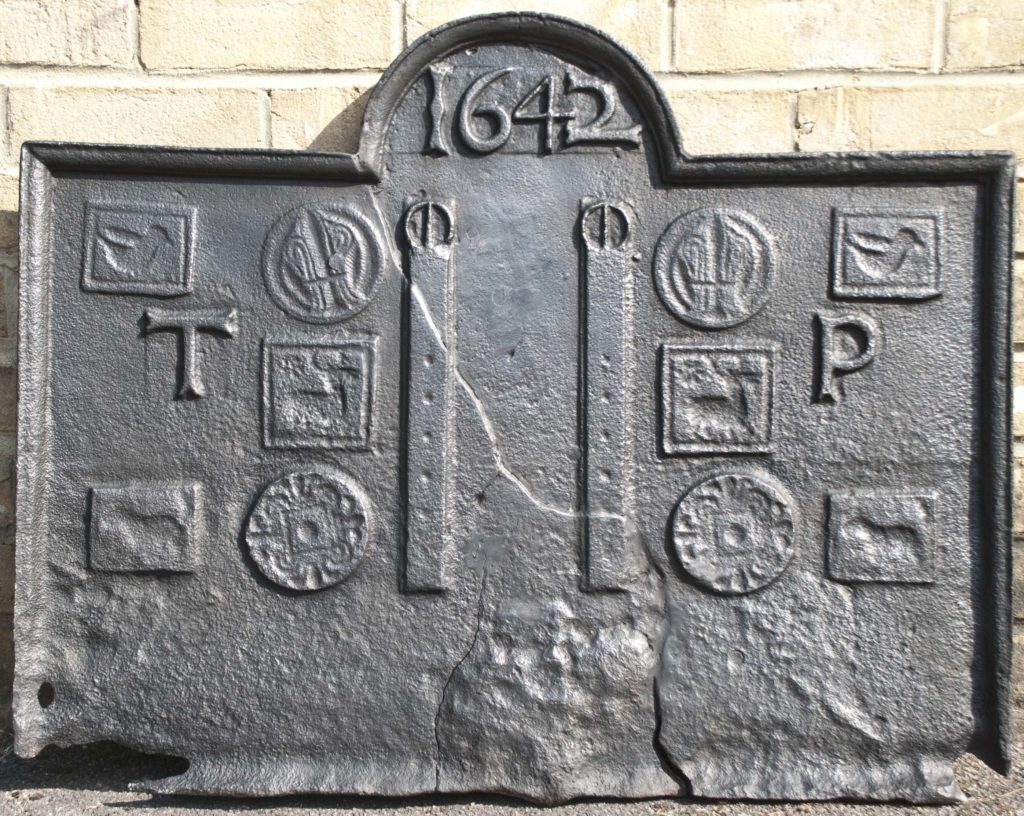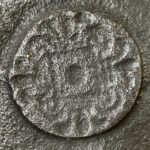Sir Thomas Pelham (1597-1654) owned the iron furnace at Waldron in Sussex and it had been in his family since his grandfather’s time. Sir Thomas was a hands-on owner although he left the day-to-day running of the works to his founder and to a clerk who kept the accounts. Most of the iron made there was pig iron that was sent to the family’s two forges to be converted into wrought iron and sold to blacksmiths and ironmongers. But periodically other pieces of ironwork were cast, with firebacks among them.

In 1642, for what reason we do not know, a distinctive fireback began to be produced at Waldron. Of simple ‘Palladian’ shape, it bore the date, together with Thomas Pelham’s initials, and two straps each with a buckle at the top end. The buckle was the Pelham family’s badge, earned, it was said, by one of Sir Thomas’s ancestors at the Battle of Poitiers in 1356 when he played an important role in the capture of the French king, John II. The buckle was subsequently incorporated into the family’s coat of arms.

The pattern for the fireback would have been formed from two boards battened together, the top one shaped with a central arch, and the two parts edged with ovolo moulding. It can be seen from the casting on the left and from the faint outlines surrounding their images that the date was separately carved and fixed to the top board, as were the initials. The straps with buckles were also carved from wood in imitation of leather and metal and fixed across the two boards. In this form the pattern could be used over and over again producing as many identical firebacks as were needed. And in that basic form a number of examples still exist.

The lower parts of firebacks were often left undecorated because when situated at the back of a fireplace it was that part that was most affected by the heat from the fire and was often hidden by the inevitable accumulation of ash. However, customers who turned up at Waldron Furnace wishing to purchase a fireback and offered the standard pattern from which they could have a casting made, might have wanted something that differed a little from the plain original. In this example a larger fireback has been made by impressing the original pattern into a wider bed of casting sand and adding two extra initials. The basic pattern need not have been damaged despite the apparent removal of the edging from three sides, as all the founder needed to do was to fill in where the edging had indented the sand bed and smooth it over.

As well as having extra letters available, the furnace evidently had a stock of small carved stamps that could be used to decorate firebacks to their purchasers’ choosing. This heavily worn and cracked casting had a stamp of a small bird impressed four times along the top and a stamp of what appears to be a deer added a couple of times below Sir Thomas’s initials.

In the late-19th century a Mr Edward Hughes of Heathfield in Sussex sketched this fireback at a farmhouse in Waldron, less than half a mile from where the furnace had stood. Obviously of the same type, it had been decorated enthusiastically with the deer stamps as well at least two other different stamps, which were repeated several times. Alas, an enquiry at the farm where it had been recorded by Mr Hughes revealed that it was no longer there.

A chance email from a fellow fireback enthusiast led me to an auction where this fireback was going under the hammer. Its sorry state was reflected in the estimated price of £5 but clearly some of the stamps with which it had been decorated were those on the example Mr Hughes had seen and sketched. The only way I was going to be able to record it properly was for me to buy it and as the only bidder I paid the estimate plus the usual buyer’s premium. A friend generously fitted the two parts together by screwing two steel plates onto the back and, cleaned up and with stove polish applied, its detail can be seen in its full glory.


The deer stamps and small bird stamps are the same as those on the casting in the collection at Hastings Museum, although the birds were not on the Hughes sketch. In addition, however, are a dog stamp and a circular stamp resembling a fleur-de-lys, which may have been a recycled butter mould; both of these were recorded by Mr Hughes. Finally there is another round stamp but with a symmetrical arrangement of a square and four small fleurs-de-lys, not seen on any of the other 1642 firebacks but which was something like one I had seen on another fireback. Could they be the same and, if so, would that indicate that the other fireback had also been made at Waldron Furnace?


The fireback in question is in the Victoria and Albert Museum. It is of an altogether earlier style, more typical of the 16th century and has an ‘M’ or two inverted ‘V’ shapes formed by impressed lengths of twisted rope; these are likely to be an apotropaic, or evil-averting, symbol associated with the Virgin Mary. The circular stamp is in its clearest form at the top of the fireback. Its diameter is 10.5cm. This compares with 10.2cm for the equivalent stamp on the 1642 fireback, a matter of a mere 1.5mm on each side, which can easily be accounted for by the condition. Although not as well-defined on the 1642 back the decorative pattern on the stamp is the same on both firebacks, which leads me to believe that the V&A casting was made at Waldron and that this circular stamp had been part of a stock of stamps available for the decoration of firebacks made there.

By way of a postscript, Barry Lucas, an old friend of my father, made sketches of three firebacks he had seen at Catsfield Place in Sussex and in 1950 published them in a short note in the, now sadly defunct, Sussex County Magazine. Catsfield Place had been the home of Sir Nicholas Pelham, Sir Thomas Pelham’s youngest son. One of the firebacks he sketched, seen here, has nine round stamps and I wonder if they might be the same stamps that are on the V&A fireback. One day I hope to obtain permission to verify this.